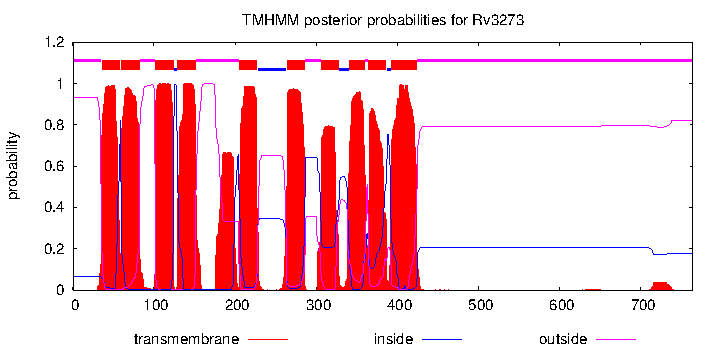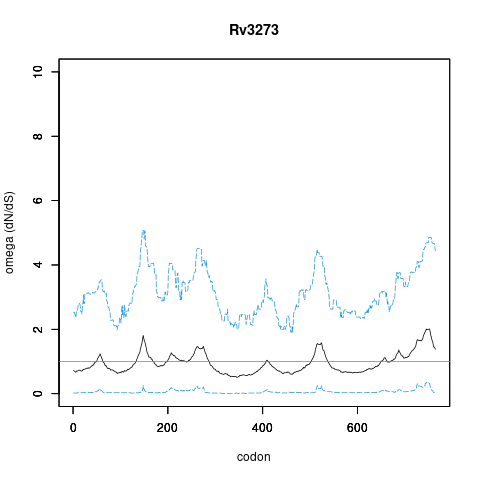Rv3273 (-)
Current annotations:
TBCAP: (community-based annotations - see table at bottom of page )
TBDB: carbonic anhydrase
REFSEQ: transmembrane carbonic anhydrase
PATRIC: Carbonic anhydrase (EC 4.2.1.1)
TUBERCULIST: Probable transmembrane carbonic anhydrase (carbonate dehydratase) (carbonic dehydratase)
NCBI: Probable transmembrane carbonic anhydrase (carbonate dehydratase) (carbonic dehydratase)
updated information (H37Rv4):
gene name: -
function:
reference:
Type: Not Target
Start: 3654637
End: 3656931
Operon:
Trans-membrane region:
Role: IV.I - Miscellaneous phosphatases, lyases, and hydrolases
GO terms:
GO:1902358 - sulfate transmembrane transport (Uniprot)
GO:0055085 - transmembrane transport (Uniprot)
GO:0016021 - integral component of membrane (Uniprot)
GO:0016020 - membrane (Uniprot)
GO:0015976 - carbon utilization (Uniprot)
GO:0015116 - sulfate transmembrane transporter activity (Uniprot)
GO:0008272 - sulfate transport (Uniprot)
GO:0008271 - secondary active sulfate transmembrane transporter activity (Uniprot)
GO:0008270 - zinc ion binding (Uniprot)
GO:0005887 - integral component of plasma membrane (Uniprot)
GO:0005886 - plasma membrane (Uniprot)
GO:0004089 - carbonate dehydratase activity (Uniprot)
Reaction(s) (based on iSM810 metabolic model):
Gene Expression Profile Gene Modules Orthologs among selected mycobacteria Protein structure:
Search for Homologs in PDB Top 10 Homologs in PDB (as of Nov 2020): (none with >35% aa id)
Links to additional information on Rv3273:
Amino Acid Sequence
VTIPRSQHMSTAVNSCTEAPASRSQWMLANLRHDVPASLVVFLVALPLSLGIAIASGAPIIAGVIAAVVGGIVAGAVGGSPVQVSGPAAGLTVVVAELID
ELGWPMLCLMTIAAGALQIVFGLSRMARAALAIAPVVVHAMLAGIGITIALQQIHVLLGGTSHSSAWRNIVALPDGILHHELHEVIVGGTVIAILLMWSK
LPAKVRIIPGPLVAIAGATVLALLPVLQTERIDLQGNFFDAIGLPKLAEMSPGGQPWSHEISAIALGVLTIALIASVESLLSAVGVDKLHHGPRTDFNRE
MVGQGSANVVSGLLGGLPITGVIVRSSANVAAGARTRMSTILHGVWILLFASLFTNLVELIPKAALAGLLIVIGAQLVKLAHIKLAWRTGNFVIYAITIV
CVVFLNLLEGVAIGLVVAIVFLLVRVVRAPVEVKPVGGEQSKRWRVDIDGTLSFLLLPRLTTVLSKLPEGSEVTLNLNADYIDDSVSEAISDWRRAHETR
GGVVAIVETSPAKLHHAHARPPKRHFASDPIGLVPWRSARGKDRGSASVLDRIDEYHRNGAAVLHPHIAGLTDSQDPYELFLTCADSRILPNVITASGPG
DLYTVRNLGNLVPTDPDDRSVDAALDFAVNQLGVSSVVVCGHSSCAAMTALLEDDPANTTTPMMRWLENAHDSLVVFRNHHPARRSAESAGYPEADQLSI
VNVAVQVERLTRHPILATAVAAADLQVIGIFFDISTARVYEVGPNGIICPDEPADRPVDHESAQ
(
Nucleotide sequence available on
KEGG )
Additional Information
Analysis of Positive Selection in Clinical Isolates
*new*
Analysis of dN/dS (omega) in two collections of Mtb clinical isolates using GenomegaMap (Window model) (see description of methods )
Moldova: 2,057 clinical isolates
global set: 5,195 clinical isolates from 15 other countries
In the omega plots, the black line shows the mean estimate of omega (dN/dS) at each codon, and the blue lines are the bounds for the 95% credible interval (95%CI, from MCMC sampling).
A gene is under significant positive selection if the lower-bound of the 95%CI of omega (lower blue line) exceeds 1.0 at any codon.
Moldova (2,057) global set (5,195)
under significant positive selection? NO NO
omega peak height (95%CI lower bound) 2.0 (0.35) 1.47 (0.51)
codons under selection
omega plots
genetic variants* link link
statistics at each codon link link
* example format for variants: "D27 (GAC): D27H (CAC,11)" means "Asp27 (native codon GAC) mutated to His (codon CAC) in 11 isolates"
MtbTnDB - interactive tool for exploring a database of published TnSeq datasets for Mtb
TnSeqCorr
Rv3273/-,
gene len: 2294 bp, num TA sites: 32
condition dataset call medium method notes
in-vitro DeJesus 2017 mBio non-essential 7H9 HMM fully saturated, 14 TnSeq libraries combined
in-vitro Sassetti 2003 Mol Micro non-essential 7H9 TRASH essential if hybridization ratio<0.2
in-vivo (mice) Sassetti 2003 PNAS no data BL6 mice TRASH essential if hybridization ratio<0.4, min over 4 timepoints (1-8 weeks)
in-vitro (glycerol) Griffin 2011 PPath non-essential M9 minimal+glycerol Gumbel 2 replicates; Padj<0.05
in-vitro (cholesterol) Griffin 2011 PPath non-essential M9 minimal+cholesterol Gumbel 3 replicates; Padj<0.05
differentially essential in cholesterol Griffin 2011 PPath NO (LFC=0.88) cholesterol vs glycerol resampling-SR YES if Padj<0.05, else not significant; LFC<0 means less insertions/more essential in cholesterol
in-vitro Smith 2022 eLife non-essential 7H9 HMM 6 replicates (raw data in Subramaniam 2017, PMID 31752678)
in-vivo (mice) Smith 2022 eLife non-essential BL6 mice HMM 6 replicates (raw data in Subramaniam 2017, PMID 31752678)
differentially essential in mice Smith 2022 eLife NO (LFC=0.065) in-vivo vs in-vitro ZINB YES if Padj<0.05, else not significant; LFC<0 means less insertions/more essential in mice
in-vitro (minimal) Minato 2019 mSys non-essential minimal medium HMM
in-vitro (YM rich medium) Minato 2019 mSys growth advantage YM rich medium HMM 7H9 supplemented with ~20 metabolites (amino acids, cofactors)
differentially essential in YM rich medium Minato 2019 mSys YES (LFC=2.3) YM rich vs minimal medium resampling
TnSeq Data No data currently available.
No TnSeq data currently available for this Target.
RNASeq Data No data currently available.
No RNA-Seq data currently available for this Target.
Metabolomic Profiles No data currently available.
No Metabolomic data currently available for this Target.
Proteomic Data No data currently available.
No Proteomic data currently available for this Target.
Regulatory Relationships from Systems Biology
BioCyc
Gene interactions based on ChIPSeq and Transcription Factor Over-Expression (TFOE) (Systems Biology )
NOTE:
Green edges represent the connected genes being classified as differentially essential as a result of the middle gene being knocked out. These interactions are inferred based on RNASeq.
Interactions based on ChIPSeq data
RNA processing and modification
Energy production and conversion
Chromatin structure and dynamics
Amino acid transport and metabolism
Cell cycle control, cell division, chromosome partitioning
Carbohydrate transport and metabolism
Nucleotide transport and metabolism
Lipid transport and metabolism
Coenzyme transport and metabolism
Translation, ribosomal structure and biogenesis
Cell wall/membrane/envelope biogenesis
Replication, recombination and repair
Posttranslational modification, protein turnover, chaperones
Secondary metabolites biosynthesis, transport and catabolism
Inorganic ion transport and metabolism
General function prediction only
Intracellular trafficking, secretion, and vesicular transport
Signal transduction mechanisms
Differentially expressed as result of RNASeq in glycerol environment (Only top 20 genes shown sorted by log fold change with p_adj 0.05).
Conditionally essential as result of TNSeq (Only top 20 genes shown sorted by log fold change with p_adj 0.05).
Binds To:
No bindings to other targets were found.
Bound By:
No bindings from other targets were found.
Binds To:
No bindings to other targets were found.
Bound By:
Upregulates:
Does not upregulate other genes.
Upregulated by:
Not upregulated by other genes.
Downregulates:
Does not downregulate other genes.
Downregulated by:
Not downregulated by other genes.
Property Value Creator Evidence PMID Comment
Citation A postgenomic method for predicting essential genes at subsaturation levels of mutagenesis: application to Mycobacterium tuberculosis. authors,G. Lamichhane,M. Zignol,NJ. Blades,DE. Geiman,A. Dougherty,J. Grosset,KW. Broman,WR. Bishai Proc. Natl. Acad. Sci. U.S.A. 2003 njamshidi ISS 12657046|12775759 PMID: 12657046, 12775759
Term EC:4.2.1.1 Carbonate dehydratase. - ISS njamshidi ISS 12657046|12775759 PMID: 12657046, 12775759authors,G. Lamichhane,M. Zignol,NJ. Blades,DE. Geiman,A. Dougherty,J. Grosset,KW. Broman,WR. Bishai A postgenomic method for predicting essential genes at subsaturation levels of mutagenesis: application to Mycobacterium tuberculosis. Proc. Natl. Acad. Sci. U.S.A. 2003
Term TBRXN:HCO3E HCO3 equilibration reaction - ISS njamshidi ISS 12657046|12775759 PMID: 12657046, 12775759authors,G. Lamichhane,M. Zignol,NJ. Blades,DE. Geiman,A. Dougherty,J. Grosset,KW. Broman,WR. Bishai A postgenomic method for predicting essential genes at subsaturation levels of mutagenesis: application to Mycobacterium tuberculosis. Proc. Natl. Acad. Sci. U.S.A. 2003
Citation Genes required for mycobacterial growth defined by high density mutagenesis. authors,CM. Sassetti,DH. Boyd,EJ. Rubin Mol. Microbiol. 2003 njamshidi IDA 12657046|12775759 PMID: 12657046, 12775759
Term EC:4.2.1.1 Carbonate dehydratase. - IDA njamshidi IDA 12657046|12775759 PMID: 12657046, 12775759authors,CM. Sassetti,DH. Boyd,EJ. Rubin Genes required for mycobacterial growth defined by high density mutagenesis. Mol. Microbiol. 2003
Term TBRXN:HCO3E HCO3 equilibration reaction - IDA njamshidi IDA 12657046|12775759 PMID: 12657046, 12775759authors,CM. Sassetti,DH. Boyd,EJ. Rubin Genes required for mycobacterial growth defined by high density mutagenesis. Mol. Microbiol. 2003
Citation A postgenomic method for predicting essential genes at subsaturation levels of mutagenesis: application to Mycobacterium tuberculosis. authors,G. Lamichhane,M. Zignol,NJ. Blades,DE. Geiman,A. Dougherty,J. Grosset,KW. Broman,WR. Bishai Proc. Natl. Acad. Sci. U.S.A. 2003 njamshidi IDA 12657046|12775759 PMID: 12657046, 12775759
Term EC:4.2.1.1 Carbonate dehydratase. - IDA njamshidi IDA 12657046|12775759 PMID: 12657046, 12775759authors,G. Lamichhane,M. Zignol,NJ. Blades,DE. Geiman,A. Dougherty,J. Grosset,KW. Broman,WR. Bishai A postgenomic method for predicting essential genes at subsaturation levels of mutagenesis: application to Mycobacterium tuberculosis. Proc. Natl. Acad. Sci. U.S.A. 2003
Term TBRXN:HCO3E HCO3 equilibration reaction - IDA njamshidi IDA 12657046|12775759 PMID: 12657046, 12775759authors,G. Lamichhane,M. Zignol,NJ. Blades,DE. Geiman,A. Dougherty,J. Grosset,KW. Broman,WR. Bishai A postgenomic method for predicting essential genes at subsaturation levels of mutagenesis: application to Mycobacterium tuberculosis. Proc. Natl. Acad. Sci. U.S.A. 2003
Citation Genes required for mycobacterial growth defined by high density mutagenesis. authors,CM. Sassetti,DH. Boyd,EJ. Rubin Mol. Microbiol. 2003 njamshidi ISS 12657046|12775759 PMID: 12657046, 12775759
Term EC:4.2.1.1 Carbonate dehydratase. - ISS njamshidi ISS 12657046|12775759 PMID: 12657046, 12775759authors,CM. Sassetti,DH. Boyd,EJ. Rubin Genes required for mycobacterial growth defined by high density mutagenesis. Mol. Microbiol. 2003
Term TBRXN:HCO3E HCO3 equilibration reaction - ISS njamshidi ISS 12657046|12775759 PMID: 12657046, 12775759authors,CM. Sassetti,DH. Boyd,EJ. Rubin Genes required for mycobacterial growth defined by high density mutagenesis. Mol. Microbiol. 2003


